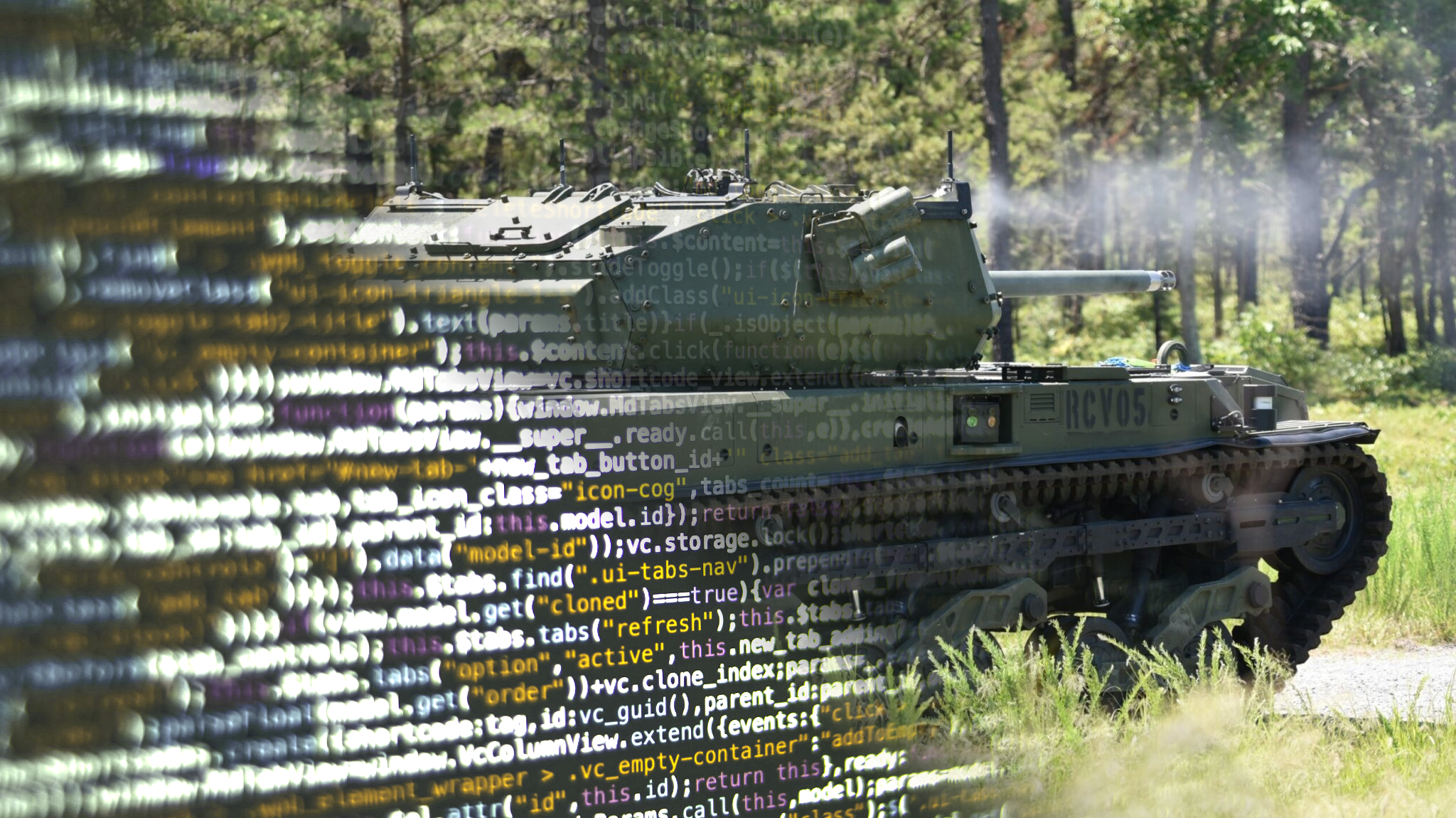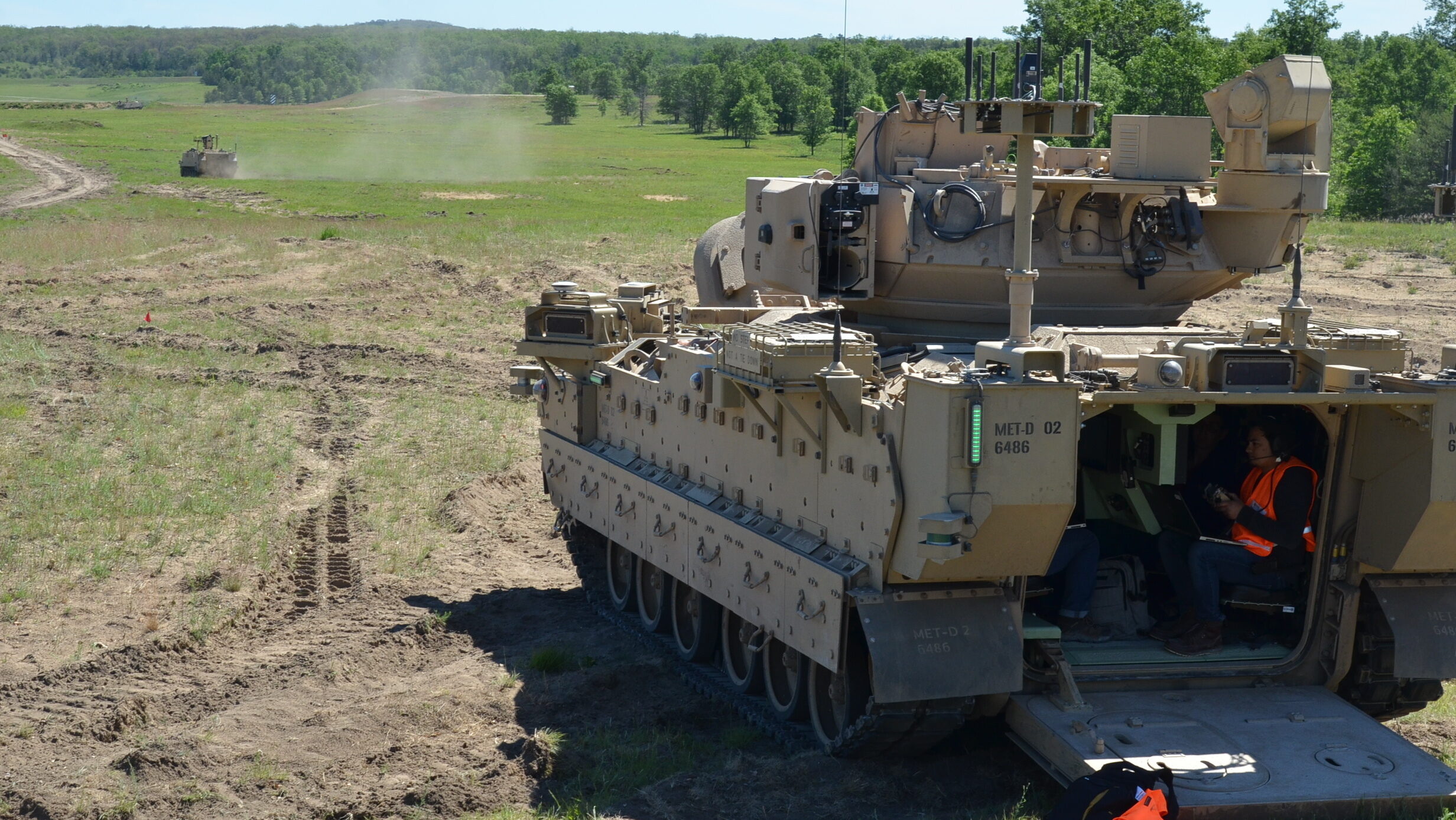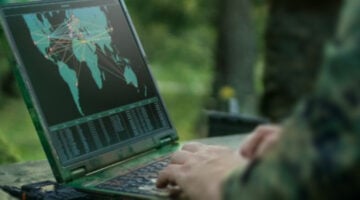
WASHINGTON — Earlier this year, a group of US Army robotic trucks rolled out on Saudi Arabia’s highways. And among the heat, sand and overpasses, things didn’t go as planned.
At first, the robotic drivers of the trucks would roll along fine, but when the vehicles’ radars or Light Detection and Ranging (LIDAR) systems detected something like an upcoming speed bump or a bridge, the associated software would register those everyday road features as obstacles. The trucks were then kicked out of robotic mode or came to a halt. Better a human driver deal with such hazards, the software seemed to say.
“From a software standpoint, there’s a lot of, kind of, bugs,” Capt. Nathan Amos, the Army’s Central’s transport vehicle lead, told Breaking Defense during a recent interview.
US Marine Corps Col. Joseph Garaux with the 2nd Marine Logistics Group Forward Command Element, separately concurred, saying, “It’s not the most amazing technological breakthrough ever, but I think we’re moving in a very positive direction.”
That test was with an Army-developed Expedient Leader Follower system being retired in favor of selecting a follow-on solution. However, the service isn’t halting its internal development of that associated autonomy package, called the Robotic Technology Kernel (RTK). In fact, the technology is forming the autonomy core of the new Robotic Combat Vehicle (RCV) program, seen as a key part of the service’s unmanned future.
And that is raising red flags with industry. Over the past two months, Breaking Defense spoke with more than a dozen sources involved in the RCV program, from both the Army and industry. In many cases, those sources asked that their names or company affiliations not be used so that they could freely speak.
Together, they paint a picture of a program to which the service is absolutely committed, but which has major questions hanging in the air — and growing concerns from industry.
The chief complaint from industry sources is around the Army’s approach to the program: trying to cobble together its own robot piece by piece, without a clear competition strategy for the payloads or key communications and network equipment — essential components to make an unmanned vehicle work.
One industry source described the development and acquisition plan as “clunky at best,” while another painted a more chaotic picture: “RCV has just decided to boil the ocean and do it all simultaneously.”
Industry’s second chief complaint stems, in part, from the first. The Army, some said, is too wedded to RTK as a concept, eschewing possibly more mature autonomy options. As a result, the service knows it will initially produce a less capable robot, and one it is not sure how it will use.
Industry’s concerns are not completely falling on deaf ears. Service officials said they are hearing some of those program structure complaints from industry too. And even the most optimistic service leaders caution that RTK isn’t where it needs to be yet, and concede that soldiers will only be able to use those early robots in limited types of missions.
But they also counter that the only way to get the program to work is by putting it out in the field and seeing how things go.
“I temper my enthusiasm with the reality that I see when I look at the state of technology, I have to take a bit of an appetite suppressant and realize that what we need to do … is we just need to get capability out to the field, it’s not going to be perfect,” Brig Gen. Geoffrey Norman, the director of the Next-Generation Combat Vehicle Cross Functional Team, told Breaking Defense shortly before retiring earlier this month.
“It’s not going to be as autonomous or as capable as we want or as we might desire but we need to start getting these capabilities out into the hands of soldiers and units and forces command so they can start experimenting,” the then-one-star general added.
Despite the challenges, Norman expressed cautious optimism about the RCV program. Four other service leaders agreed, while all citing an array of challenges from testing constraints to autonomy and control concerns.
At stake is not just one program. If RCV succeeds, it could open up a whole new wave of technologies for the Army as it seeks to remove soldiers from dangerous, front-line missions. If it fails, the question of how to make robotic vehicles becomes a whole lot iffier for America’s largest military service.
In this two-part series, Breaking Defense first explores the RCV program state of play and a growing divide over the Army’s software approach that is critical to how soldiers will operate and use the robots. Part two, available here, delves into how teleoperation challenges are forcing the service to rethink its plans for how to use the RCV.
Current State of Affairs
Army leaders’ desire to use unmanned combat vehicles to keep soldiers out of harm’s way dates back to the ill-fated Future Combat System in the early 2000s. While drones took to the sky around that time, challenges on the ground — including physical obstacles like trees and buildings, combined with hesitancy to field autonomous weapons where humans live — hampered unmanned ground vehicle development and fielding.
Eventually the Army developed plans for three RCV sizes: light, medium, and heavy. After hosting a competition, in 2020 the service selected a QinetiQ North America and Oshkosh Defense team to produce the smaller prototype based on a “variant” of the Expeditionary Modular Autonomous Vehicle, while Textron produced an RCV-Medium called the Ripsaw M5.
The Army is still experimenting with those vehicles, but in 2022 the service changed course, launching a new prototyping competition for a single variant with plans to spend just over $900 million on development between fiscal 2023 and 2029, according to the most recent budget request documents. But this time around, the service is splitting apart the platform, software, payloads and communications package.

To find the actual vehicle, the Army has partnered with the National Advanced Mobility Consortium to source a flatbed RCV no larger than 224 x 88 x 94 inches, weighing under 10 tons, and transportable by rotary wing aircraft. In September 2023, four companies — McQ, Textron Systems, General Dynamics Land Systems, and Oshkosh Defense — received contracts totaling $24.7 million for the first project phase.
By this August, each team is expected to deliver two RCVs for mobility and soldier testing, with a Phase II down-selection expected in early 2025.
Maj. Gen. Glenn Dean, the service’s Program Executive Officer for Ground Combat Systems, spoke with Breaking Defense twice for this series and said that while he would like to keep more than one vendor on contract for the upcoming phase, budget constraints will likely force the service to only pick one.
Presuming his prediction comes to fruition, the winning team will receive additional requirements to produce an updated vehicle prototype before program officials decide how to proceed in fiscal 2027, according to recent budget justification documents and previous Army statements. If it’s greenlit to proceed, soldiers could be using the unmanned vehicles the following year.
But this is just a portion of what the Army needs to produce a new class of unmanned combat vehicles.
Building A Robot
As service officials plot the course ahead for acquiring the core RCV platform, they are also separately planning to either internally develop or commercially acquire key components to integrate into that platform.
That laundry list includes payloads to fire or to use to clear minefields. Autonomy software is also needed to enable the robots to maneuver on their own, as is communications equipment to link up soldiers with the vehicles so that they can help with navigation or instruct the platforms to fire. And those soldiers need a control vehicle to house their equipment and trail behind.
The challenge, industry figures told Breaking Defense, is that the Army’s plans to acquire all those additional critical parts are in various stages, and there is a lack of communication from the Army about how they will all line up.
Just last month, for example, a BAE Systems official told reporters his company began talking with the service about ways to use the moving out with development of an Armored Multi-Purpose Vehicle as the program’s control vehicle. Silvus Technologies, meanwhile, is currently providing the radios for that critical communications link. But multiple industry sources said it remains unclear how the government plans to competitively downselect many of the other subcomponents and once it does, will it internally integrate those onto the platforms or pick a prime integrator.
“The Army needs to be in the business of defining clear end-state requirements in partnership with industry and demanding capable products versus trying to be their own systems integrator and software provider,” one industry source said.
Because the Army is banking on incremental upgrades over time, the service could rush a robot to the field with the intention of upgrading it later. As a result, a second industry source said, the Army could inadvertently field “garbage” RCVs soldiers discard.
“The actual question is ‘can the government build a self-driving car?,” a third industry source said. “Or do we believe the commercial tech industry can build something better?”
Underpinning their concerns is a spotty track record from the Army with internal development and upgrade projects.
Earlier this year, for example, the service announced that it was canceling work on the Extended Range Cannon Artillery (ERCA) platform — an internal development effort to add a longer gun and autoloader to its Paladin M109A7 self-propelled howitzer. Its modified Stryker with Maneuver-Short Range Air Defense (M-SHORAD) capabilities, now called Sergeant Stout, was also once a struggling internal integration effort that was eventually turned over to industry for integration. That project has fared better than ERCA and is now fielded, but not everything works as it should.
Dean acknowledged some of those past internal development challenges but said the service is actually “spreading our risks” with RCV by not going with a single end-to-end solution, which could wed them to a system that ends up the wrong fit down the road.
“We’re not making the irrevocable decisions about a capability because once I have one, it’s a mobile platform with a deck that I can plug in power and data and I have a sense and compute capability,” the two-star general added.
One well-placed Army source noted the challenges with the service’s approach, but said there is a risk mitigation plan in place that includes making sure all components adhere to RCV specifications to make sure everything works together.
“You can Frankenstein some crazy looking robot with lots of different non-visually appealing systems, but we know that it will always fit, it will always be to spec,” he said.

RTK: The Right Path?
That brings up the second complaint from industry around the program: That even as it pursues an open-ended, multi-part procurement from industry, the most important part of the RCV program — its autonomy, the brain that makes it truly useful in the field — is the one part the service wants to do internally. And, everyone agrees, the software simply isn’t where it should be at this point.
Although the Army’s Combat Capabilities Development Command’s Ground Vehicle Systems Center (GVSC) has been developing the RTK software for 12-plus years with support from industry and government research labs, it only really got its first test in 2023 while abroad at a base in Kuwait. There they began using older, legacy RTK software before it was updated to a newer version for the test in Saudi Arabia. (Technically, the Army has rebranded RTK as the “Army Robotic Common Software,” but the vast majority of those who talked with Breaking Defense still used the old acronym.)
In order to use it on those Saudi roads, Amos, the Army captain, said a safety operator was required to be behind the wheel at all times, the trucks had to maintain slower speeds and escort vehicles were needed. Operating within those constraints, the service saw firsthand the challenges facing their autonomy software, such as the issues with processing basic road signs reading as obstacles.
“If we have the system software and the hardware all in sync, then we are not experiencing the numerous kinds of issues or errors that we experienced throughout the process of this convoy,” Amos explained. While the services found a host of RTK challenges, Amos added that they also saw some of the potential benefits fielding such a technology will bring, including saving lives.
Michael Cadieux, director of the Army’s GVSC, confirmed the issues and stated that his team is refining the RTK behavior requirements to determine which scenarios should trigger the vehicles to stop or switch to manual mode. Every six months or so, he added, larger software updates are released and tested.
For now, the service seems dedicated to having an internally developed system, in part so that they are not reliant on a single autonomy vendor and can eventually funnel RTK into other robots, Dean explained.
“I’m really assembling a toolkit of autonomy behaviors and actions,” Dean explained. “And, each tool is some software company’s product … [or] some of them might provide the box that I store the tools in but our intent is not to buy a complete turnkey toolkit from one company.”
Complicating matters further, RTK is not the only autonomy effort for RCV the Army is looking at.
The service has a completely separate RCV software initiative through the Defense Innovation Unit called the Ground Vehicle Autonomous Pathways (GVAP) project. Through that initiative, it has handed out a host of contracts for three RCV software pipelines — autonomous navigation, machine learning and autonomy, and software system integrators.

Currently, four companies all have taxpayer-funded deals for that autonomous navigation pipeline (Forterra, Kodiak Robotics, Neya Systems and Overland AI), while two companies (Applied Intuition and Scale AI) are under the machine learning and autonomy umbrella, and two more (Anduril and Palantir) have ones to be the software system integrator.
The problem is, according to industry sources, there doesn’t appear to be a plan for how any that GVAP work will ever be funneled into the RCV program, especially since the Army says it is still dedicated to using RTK. And if there is a plan, the Army hasn’t communicated it.
Dean conceded the industry has a right to say it’s confused, but is confident there is a plan in place. The goal, he explained, is not to select one winner from those autonomy pipelines.
“It’s not that there’s a downselect. We have a range of individual investments, each one of them, we periodically assess to say, ‘Hey they’re making progress. Is that something you want to continue?’” Dean said. The two-star general said the service has asked those autonomy navigation companies to demonstrate their capabilities out at Ft. Cavazos in Texas this summer to help the service “benchmark” the state of commercial autonomy and drive decisions as it assembles its RTK “library.”
One such option under consideration involves the Army ultimately trying to purchase an algorithm for a one-time payment and then funnel it into RTK.
But that’s likely a no-go for some software companies who aren’t interested in selling off one algorithm and having it added to a flawed autonomy initiative, one industry source explained. The entire set up, that source added, is a move by the Army to shield the death of its own autonomy investment, and act as the integrator, supplier and buyer.
“The government is saying commercial [autonomy software] is too expensive without actually running a competitive process or soliciting pricing at volumes for the program,” the source said, adding “We encourage the government to competitively and commercially complete this program.”
A separate industry source and Dean countered that acquiring software as a service isn’t a good deal for the Army because the government would have to shell out dollars each time it wants to make adjustments to the operating system. That kind of contract would provide regular dollars for the winner, and living off sustainment money is a time-honored tradition for the defense industry.
But at the same time, those software companies are uniquely set up to develop and maintain that kind of software, and US code stipulates a preference for commercial products and services when feasible.
Some lawmakers, meanwhile, are taking note of the mushrooming controversy, calling on the Army to reconsider its RCV software plan. When members of Senate Armed Services Committee released their version of the fiscal 2025 defense authorization bill [pdf], the panel noted that there are multiple commercial products available that enable “advanced ground autonomy” for large and small vehicles.
“The committee is concerned that the US Army continues to fund the Robotic Technology Kernel. … The committee believes the US Army should reexamine its funding decisions and consider further engagement with providers in the ground autonomy industrial base,” senators wrote.
It is not clear if that language will ultimately remain in the legislation or prompt the service to act in any way.
But for now, service officials like Dean do not expect to have a high-level of autonomy in those early RCVs. That means soldiers will be required to stick close by to teleoperate nearly every move which poses an entirely different set of challenges since the invisible radio tether used to do that can easily be severed due to distance, terrain or electronic warfare.
As a result, the service is looking for ways to improve the communications link and decide just how soldiers can initially use those early, limited robots.
Agnes Helou contributed to this report from Beirut.

